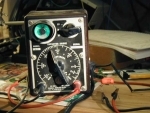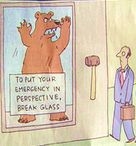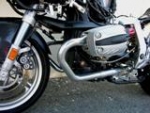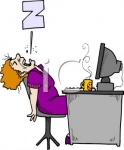Two completely contradictory sleep studies
Two completely contradictory sleep studies
Hi:
19 yrs ago in PA I underwent an abrupt turn for the worse, from being able to stay alert in meetings and otherwise normal, except for some off/on insomnia, to severe fatigue.
So I went through a battery of medical tests and exams, all turning up nothing. Hypotheses of CFS, Fibromyalgia, hypoglycemia, candida, etc. all just didn't quite make it to any official diagnosis. Finally, a sleep study was done. The results of study #1:
Zero apneas, min O2 of 92%. PLMD index 2.3/hr and 5.4/hr isolated leg movements (ILMS), with 8 arousals related to leg movements. They noted that I had difficulty returning to sleep after an arousal, yet remarked "sleep was adequate in quality and quantity. Sleep arch. reveals reduced sleep eff. of 64% and prolonged sleep latency of 44min. A mild degree of fragmentation..."
I aborted my Ph.D. track academic path to get a job in CA in 1999, and got married in 2000. I excelled at my job, despite living a secret hell of struggling to remain alert and focus on tasks. But over the past few years, the situation has deteriorated further. Now I can barely hold my head off the desk most days.
A few years ago, my PCP did some more testing. The only thing that turned up was a high EBV antibody count. I figured my situation was hopeless until a work Dr. convinced me to try another sleep study. So I went to Stanford. The results of study #2:
AHI=15/hr, lowest O2=91%, "flow limitation not included in AHI but disrupting sleep was noted in 85% of total sleep time." PLMi=0!
These results are completely the opposite of the past results. Though the disturbed sleep is still there. This time, the EEG shows at least 15 awakenings (not perceived by me).
So I am perplexed by this. Since it does appear that I have OSA, but it appears mild, and my O2 doesn't go very low, I gather from what I've read here that mild OSA cases with not very severe O2 desats. are the least likely to benefit from CPAP. Is that correct?
What do you think is my prognosis? I have yet to have my followup visit to discuss the lab results with the Drs. I have a pretty open mind, and have been mentally preparing myself for the idea of living the hosehead life. If that can possibly makes me feel better, I'm willing to commit some serious time and effort to trying to get it to work.
But there are just two worries: I have a rather nervous personality, prone to insomnia in general, and I can never, ever sleep on my back anymore. I always side sleep.
Thanks for comments.
19 yrs ago in PA I underwent an abrupt turn for the worse, from being able to stay alert in meetings and otherwise normal, except for some off/on insomnia, to severe fatigue.
So I went through a battery of medical tests and exams, all turning up nothing. Hypotheses of CFS, Fibromyalgia, hypoglycemia, candida, etc. all just didn't quite make it to any official diagnosis. Finally, a sleep study was done. The results of study #1:
Zero apneas, min O2 of 92%. PLMD index 2.3/hr and 5.4/hr isolated leg movements (ILMS), with 8 arousals related to leg movements. They noted that I had difficulty returning to sleep after an arousal, yet remarked "sleep was adequate in quality and quantity. Sleep arch. reveals reduced sleep eff. of 64% and prolonged sleep latency of 44min. A mild degree of fragmentation..."
I aborted my Ph.D. track academic path to get a job in CA in 1999, and got married in 2000. I excelled at my job, despite living a secret hell of struggling to remain alert and focus on tasks. But over the past few years, the situation has deteriorated further. Now I can barely hold my head off the desk most days.
A few years ago, my PCP did some more testing. The only thing that turned up was a high EBV antibody count. I figured my situation was hopeless until a work Dr. convinced me to try another sleep study. So I went to Stanford. The results of study #2:
AHI=15/hr, lowest O2=91%, "flow limitation not included in AHI but disrupting sleep was noted in 85% of total sleep time." PLMi=0!
These results are completely the opposite of the past results. Though the disturbed sleep is still there. This time, the EEG shows at least 15 awakenings (not perceived by me).
So I am perplexed by this. Since it does appear that I have OSA, but it appears mild, and my O2 doesn't go very low, I gather from what I've read here that mild OSA cases with not very severe O2 desats. are the least likely to benefit from CPAP. Is that correct?
What do you think is my prognosis? I have yet to have my followup visit to discuss the lab results with the Drs. I have a pretty open mind, and have been mentally preparing myself for the idea of living the hosehead life. If that can possibly makes me feel better, I'm willing to commit some serious time and effort to trying to get it to work.
But there are just two worries: I have a rather nervous personality, prone to insomnia in general, and I can never, ever sleep on my back anymore. I always side sleep.
Thanks for comments.
_________________
| Mask: Swift™ FX Nasal Pillow CPAP Mask with Headgear |
| Humidifier: S9™ Series H5i™ Heated Humidifier with Climate Control |
| Additional Comments: Software: Sleepyhead v0.9.2-1 |
__________
Good day!
Good day!
Re: Two completely contradictory sleep studies
Welcome to the forum. My heart goes out to you in your situation, which is obviously very frustrating to you. I can empathize with the symptoms of chronic fatigue having a dramatic ability to interfere with your plans and quality of life.
Although others will be better able to answer some of your questions, I can reassure you that if you begin CPAP therapy, you will not be relegated to having to sleep on your back. I also am a side/stomach sleeper and have managed to do well continuing to sleep on my sides while using a full face mask and standard pillows. There are nasal masks and special pillows you can use that would make side sleeping even easier.
Issues you mentioned such as involuntary leg movements and a “nervous personality” have the potential of being treated with certain antidepressant drugs. Have you yet explored any types of psychotherapy or psychopharmacological treatments for your situation? There are perhaps some potential benefits from cognitive-behavioral therapy or psychiatry that could help you in your situation, if other physiological causes have been ruled-out.
Good luck in your situation. I hope you are able to get a satisfactory resolution to your symptoms.
Although others will be better able to answer some of your questions, I can reassure you that if you begin CPAP therapy, you will not be relegated to having to sleep on your back. I also am a side/stomach sleeper and have managed to do well continuing to sleep on my sides while using a full face mask and standard pillows. There are nasal masks and special pillows you can use that would make side sleeping even easier.
Issues you mentioned such as involuntary leg movements and a “nervous personality” have the potential of being treated with certain antidepressant drugs. Have you yet explored any types of psychotherapy or psychopharmacological treatments for your situation? There are perhaps some potential benefits from cognitive-behavioral therapy or psychiatry that could help you in your situation, if other physiological causes have been ruled-out.
Good luck in your situation. I hope you are able to get a satisfactory resolution to your symptoms.
Re: Two completely contradictory sleep studies
Welcome to the forum.
On the first big question: Why two completely "contradictory" sleep studies?
I think it's as simple as the enormous amount of time that elapsed between the two studies. You indicate that there was at least 10 or 15 years between the two studies. A lot can change with one's health in 10-15 years.
Perhaps at the time of the first study your sleep disordered breathing had not yet developed---it is a progressive disorder after all. Or perhaps it was because your sleep disordered breathing was manifesting itself as UARS back at the time of the first sleep study---which was almost twenty years ago. And back then, they weren't yet looking for UARS. Or perhaps it's because twenty years ago hypopneas were scored under what is now called Rule 4A---which requires a 4% O2 desat. And you don't desat. But sleep medicine has come a long way in the last twenty years and one thing that's changed is not just focusing on desats, but also focusing on the repeated arousals that sleep disordered breathing can lead to. Rule 4B for hypopneas allows a lab to score a hypopnea if there is a 50% drop in the amount of airflow into/out of your lungs for 10 seconds AND there is an EEG arousal at the end of it. And note that an EEG arousal is not the same as an EEG awakening.
So I think calling the studies "contradictory" is a bit too strong. After all, if you had a test done for diabetes in 2000 and it came up negative and you had a second test for diabetes in 2010 and it came up positive, would you say the tests were contradictory? Or would you conclude that you developed type II diabetes at some point during the ten years between the tests.
You also write:
Next, the folks who tend to react least positively to CPAP are those who have the fewest daytime symptoms---regardless of the actual severity of their OSA. And the severity of the daytime symptoms does not always depend on the severity of the OSA. Some people with very mild OSA find it almost incapacitating in terms of their daytime functioning. And some folks with severe apnea don't really feel sleepy or tired in the daytime.
So don't automatically assume that CPAP won't help you all that much.
Finally you write:
Second, attitude and a willingness to make a commitment are critically important. And you seem to have that covered. And you seem to be realistic in not expecting an instant cure, but rather have an understanding that adjusting to CPAP may take some serious time and effort on your part.
But third and finally, you say you're a nervous sort to begin with and a bit prone to insomnia. Those two things describe me to a T. And these two things can make it a bit harder to adjust to CPAP.
I'm a far outlier when it comes to "how long did it take to start feeling better" and my story is pretty well known around here: I started CPAP on September 23, 2010. And I immediately felt much worse on CPAP than I had before CPAP. And it took me months of hard work to just begin adjusting. And during the early dark days, my pre-cpap occasional, not really a problem insomnia grew into a very large insomnia monster. At the end of my first three months of therapy I realized that my problems were more insomnia-based at that point than strictly CPAP-adjustment based. And it took me five or six more months of hard CBT work on the insomnia to bring it under control. But finally---some eight or nine months after starting therapy I began to feel better on most days with the CPAP than I had before starting CPAP. And during the last year, I've continued to notice very slow, but steady progress in how I feel with CPAP. And in the end, much as I hate having to sleep with a hose on my nose, I'm actually quite glad that I didn't give up and that I did fight this through. Not only am I doing serious good for my long term health, but on my best days, I feel much younger than I have in years.
And I tell you all of this as a way that you can perhaps learn the lessons that I had to learn the hard way without doing it the hard way: If I had it all to do over again, I would have started listening to the PA the first time she started mentioning that I needed to get more serious about figuring out what I wanted to do with the insomnia, which was about a month into therapy. Had I started doing the CBT for insomnia then I might have saved myself a lot of grief and misery. But I wasn't ready to listen at that point.
Best of luck with your follow ups with the doctor and getting started on some kind of therapy for this---be it CPAP of some sort or something else.
On the first big question: Why two completely "contradictory" sleep studies?
I think it's as simple as the enormous amount of time that elapsed between the two studies. You indicate that there was at least 10 or 15 years between the two studies. A lot can change with one's health in 10-15 years.
Perhaps at the time of the first study your sleep disordered breathing had not yet developed---it is a progressive disorder after all. Or perhaps it was because your sleep disordered breathing was manifesting itself as UARS back at the time of the first sleep study---which was almost twenty years ago. And back then, they weren't yet looking for UARS. Or perhaps it's because twenty years ago hypopneas were scored under what is now called Rule 4A---which requires a 4% O2 desat. And you don't desat. But sleep medicine has come a long way in the last twenty years and one thing that's changed is not just focusing on desats, but also focusing on the repeated arousals that sleep disordered breathing can lead to. Rule 4B for hypopneas allows a lab to score a hypopnea if there is a 50% drop in the amount of airflow into/out of your lungs for 10 seconds AND there is an EEG arousal at the end of it. And note that an EEG arousal is not the same as an EEG awakening.
So I think calling the studies "contradictory" is a bit too strong. After all, if you had a test done for diabetes in 2000 and it came up negative and you had a second test for diabetes in 2010 and it came up positive, would you say the tests were contradictory? Or would you conclude that you developed type II diabetes at some point during the ten years between the tests.
You also write:
First of all, an AHI = 15 puts you at the border between mild and moderate sleep apnea. And the fact that flow limitations are disturbing your sleep in 85% of your total sleep time is also significant (and was probably NOT tested for back during that first sleep test.) And then there's the fact that you've got some pretty significant daytime symptoms and problems that are likely due to OSA or at least aggravated by the OSA. So all in all, I'd say that your are definitely not in the mild end of mild, but at the other end. In other words, when everything is taken into account, you may want to think of the severity of your apnea as mild to moderate OSA rather than just "mild OSA".AHI=15/hr, lowest O2=91%, "flow limitation not included in AHI but disrupting sleep was noted in 85% of total sleep time." PLMi=0!
...
So I am perplexed by this. Since it does appear that I have OSA, but it appears mild, and my O2 doesn't go very low, I gather from what I've read here that mild OSA cases with not very severe O2 desats. are the least likely to benefit from CPAP. Is that correct?
Next, the folks who tend to react least positively to CPAP are those who have the fewest daytime symptoms---regardless of the actual severity of their OSA. And the severity of the daytime symptoms does not always depend on the severity of the OSA. Some people with very mild OSA find it almost incapacitating in terms of their daytime functioning. And some folks with severe apnea don't really feel sleepy or tired in the daytime.
So don't automatically assume that CPAP won't help you all that much.
Finally you write:
First the easy stuff: Although it seems impossible to a non-hosehead, there's nothing about using a CPAP that prevents you from side sleeping. Indeed, it's important to try to maintain as much of your prefered sleeping style as possible. So go ahead and allow yourself to believe that you'll be able to continue side sleeping as a hose head.I have a pretty open mind, and have been mentally preparing myself for the idea of living the hosehead life. If that can possibly makes me feel better, I'm willing to commit some serious time and effort to trying to get it to work.
But there are just two worries: I have a rather nervous personality, prone to insomnia in general, and I can never, ever sleep on my back anymore. I always side sleep.
Second, attitude and a willingness to make a commitment are critically important. And you seem to have that covered. And you seem to be realistic in not expecting an instant cure, but rather have an understanding that adjusting to CPAP may take some serious time and effort on your part.
But third and finally, you say you're a nervous sort to begin with and a bit prone to insomnia. Those two things describe me to a T. And these two things can make it a bit harder to adjust to CPAP.
I'm a far outlier when it comes to "how long did it take to start feeling better" and my story is pretty well known around here: I started CPAP on September 23, 2010. And I immediately felt much worse on CPAP than I had before CPAP. And it took me months of hard work to just begin adjusting. And during the early dark days, my pre-cpap occasional, not really a problem insomnia grew into a very large insomnia monster. At the end of my first three months of therapy I realized that my problems were more insomnia-based at that point than strictly CPAP-adjustment based. And it took me five or six more months of hard CBT work on the insomnia to bring it under control. But finally---some eight or nine months after starting therapy I began to feel better on most days with the CPAP than I had before starting CPAP. And during the last year, I've continued to notice very slow, but steady progress in how I feel with CPAP. And in the end, much as I hate having to sleep with a hose on my nose, I'm actually quite glad that I didn't give up and that I did fight this through. Not only am I doing serious good for my long term health, but on my best days, I feel much younger than I have in years.
And I tell you all of this as a way that you can perhaps learn the lessons that I had to learn the hard way without doing it the hard way: If I had it all to do over again, I would have started listening to the PA the first time she started mentioning that I needed to get more serious about figuring out what I wanted to do with the insomnia, which was about a month into therapy. Had I started doing the CBT for insomnia then I might have saved myself a lot of grief and misery. But I wasn't ready to listen at that point.
Best of luck with your follow ups with the doctor and getting started on some kind of therapy for this---be it CPAP of some sort or something else.
_________________
| Machine: DreamStation BiPAP® Auto Machine |
| Mask: Swift™ FX Nasal Pillow CPAP Mask with Headgear |
| Additional Comments: PR System DreamStation and Humidifier. Max IPAP = 9, Min EPAP=4, Rise time setting = 3, minPS = 3, maxPS=5 |
Re: Two completely contradictory sleep studies
Hi. Sure hope this is the beginning of a resolution to your sleep problems. If your OSA is fragmenting your sleep, you stand to benefit from treatment whether your O2 Sats were low or not. Oxygen levels are of utmost importance, but are not the only detrimental aspect of sleep apnea.
One more factor I'd like to add that can cause very different sleep study results is if a person has both OSA and PLMD. There can be some masking going on and it can be challenging getting a full picture. Can't say that's your case, just that it was mine.
I think you would do yourself a great service to focus on successfully treating your OSA. You may even be pleasantly surprised to find your self-described nervous personality less nervous once your body and brain is getting proper sleep. Best wishes.
One more factor I'd like to add that can cause very different sleep study results is if a person has both OSA and PLMD. There can be some masking going on and it can be challenging getting a full picture. Can't say that's your case, just that it was mine.
I think you would do yourself a great service to focus on successfully treating your OSA. You may even be pleasantly surprised to find your self-described nervous personality less nervous once your body and brain is getting proper sleep. Best wishes.
_________________
| Mask: TAP PAP Nasal Pillow CPAP Mask with Improved Stability Mouthpiece |
| Humidifier: S9™ Series H5i™ Heated Humidifier with Climate Control |
| Additional Comments: Bleep/DreamPort for full nights, Tap Pap for shorter sessions |
My SleepDancing Video link https://www.youtube.com/watch?v=jE7WA_5c73c
Re: Two completely contradictory sleep studies
Sleeping on your back is the worst position - it provokes apneas and is very much discouraged by all, so if you do end up with a mask at night, look into something called a Pap pillow - specially made for users so they can side-sleep without dislodging a mask.
Re: Two completely contradictory sleep studies
I'm a side sleeper and have no problems while on xPAP and the nasal pillows other than a bit of an issue with some "mouth breathing" which I'm working on and is unrelated to the side sleeping as far as I know.
My sleep studies were also a bit contradictory in the fact that the first one some 6 years ago (in lab) noted that I didn't even get beyond stage 2 sleep w/ no events. My most recent (in home) study indicated a very low AHI of around 2.9 with obviously limited obstructions BUT heavy snoring along with indicators that I never reached REM stage.
My doctor is fully supportive of me still exploring the xPAP treatment because I am and have been on an array of medications both to knock me out at night and get me going in the morning due to poor sleep and being tired (pre-xPAP) throughout the days. Also suffering from depression/anxiety, high cholesterol, and reduced renal function for my age - My PCP strongly feels there could be a benefit in exploring the xPAP in thinking that if WE can improve my sleep with it, my system may likely work better in reducing some of my other medical issues and even lead to requiring less medications to treat them.
I have adapted to the xPAP fairly well and am feeling benefits overall in regards to my sleep quality and feeling more rested during the days for the most part.
I will likely have to go it on my own though unless my next sleep study which my doctor is planning does in fact qualify me with an AHI of 5 or greater as I understand for insurance requirement. Luckily, I have found a very understanding DME willing to loan me equipment and supply me with a mask during this process.
The support I have received on this forum has enabled me to pursue this and I am very grateful for that. Pugsy has been an EXTREME help to me along with many others on here.
What I am trying to say is in my opinion it is worth you pursuing the xPAP and see if it can make a difference in your sleep quality and eliminate the daytime fatigue. Realize though, it may not happen over night and could take some months along with the initial adjustment to the equipment/mask, ect...
Good luck!
My sleep studies were also a bit contradictory in the fact that the first one some 6 years ago (in lab) noted that I didn't even get beyond stage 2 sleep w/ no events. My most recent (in home) study indicated a very low AHI of around 2.9 with obviously limited obstructions BUT heavy snoring along with indicators that I never reached REM stage.
My doctor is fully supportive of me still exploring the xPAP treatment because I am and have been on an array of medications both to knock me out at night and get me going in the morning due to poor sleep and being tired (pre-xPAP) throughout the days. Also suffering from depression/anxiety, high cholesterol, and reduced renal function for my age - My PCP strongly feels there could be a benefit in exploring the xPAP in thinking that if WE can improve my sleep with it, my system may likely work better in reducing some of my other medical issues and even lead to requiring less medications to treat them.
I have adapted to the xPAP fairly well and am feeling benefits overall in regards to my sleep quality and feeling more rested during the days for the most part.
I will likely have to go it on my own though unless my next sleep study which my doctor is planning does in fact qualify me with an AHI of 5 or greater as I understand for insurance requirement. Luckily, I have found a very understanding DME willing to loan me equipment and supply me with a mask during this process.
The support I have received on this forum has enabled me to pursue this and I am very grateful for that. Pugsy has been an EXTREME help to me along with many others on here.
What I am trying to say is in my opinion it is worth you pursuing the xPAP and see if it can make a difference in your sleep quality and eliminate the daytime fatigue. Realize though, it may not happen over night and could take some months along with the initial adjustment to the equipment/mask, ect...
Good luck!
_________________
| Mask: Swift™ FX Nasal Pillow CPAP Mask with Headgear |
| Additional Comments: SleepyHead & Encore Basic Software & a Zeo |
 .....................................................
..................................................... Press ESC if the animations BUG you!.....................................................
Press ESC if the animations BUG you!.....................................................
Re: Two completely contradictory sleep studies
I also prefer to sleep on my side, and my sleep doctor also recommends side sleeping. I just use my old feather pillows, but plump and arrange them so that I can lie with my head resting towards one side of the pillows, with the mask sticking out over the edge. I may need to slightly shift the mask after I lie down to make sure it is properly positioned.Julie wrote:Sleeping on your back is the worst position - it provokes apneas and is very much discouraged by all, so if you do end up with a mask at night, look into something called a Pap pillow - specially made for users so they can side-sleep without dislodging a mask.
_________________
| Mask: Swift™ FX Nasal Pillow CPAP Mask with Headgear |
| Additional Comments: Software: SleepyHead. |
- Sir NoddinOff
- Posts: 4190
- Joined: Mon May 14, 2012 5:30 pm
- Location: California
Re: Two completely contradictory sleep studies
Not necessarily true: Sleep positions are highly individual. For non-overweight people with good lungs and hearts, sleeping on one's back is the ideal position while using XPAP. Sleeping on one's back promotes even blood distribution, makes the heart's pumping job easier, helps relax the diaphragm, lowers pressure on the brain stem (especially with the head slightly elevated), plus it allows the bone joints to rejuvenate and rebuild evenly. Once my XPAP machine opens up the airways it's a joy to roll over on my back and snooze away. COME ON BACKSLEEPERS - don't take this laying down (pun). STAND UP FOR YOURSELVES AND WEIGH IN!Julie wrote:Sleeping on your back is the worst position - it provokes apneas and is very much discouraged by all, so if you do end up with a mask at night, look into something called a Pap pillow - specially made for users so they can side-sleep without dislodging a mask.
_________________
| Mask: AirFit™ F10 Full Face Mask with Headgear |
| Additional Comments: Sleepyhead software v.0.9.8.1 Open GL and Encore Pro v2.2. |
I like my ResMed AirFit F10 FFM - reasonably low leaks for my ASV therapy. I'm currently using a PR S1 AutoSV 960P Advanced. I also keep a ResMed S9 Adapt as backup. I use a heated Hibernite hose. Still rockin' with Win 7 by using GWX to stop Win 10.
Re: Two completely contradictory sleep studies
Okay, I will chime in.Sir NoddinOff wrote:COME ON BACKSLEEPERS - don't take this laying down (pun). STAND UP FOR YOURSELVES AND WEIGH IN!
For some people (not everyone by any means) their OSA events are more frequent and/or maybe even need more pressure to deal with them when supine sleeping. While it is common it doesn't mean that everyone might fit in that category.
If there is a huge pressure difference between supine and side sleeping....like someone needs 18 on their back and 9 on their side...well yeah...try to sleep on their sides if they can do it comfortably.. The difference in pressure comfort will be substantial.
If there are no changes in pressures needed when sleeping on their back...what does it matter? The machine is delivering the pressure no matter which position someone sleeps in and if the pressure is optimal..the events will be prevented anyway.
If using an APAP machine, let the machine do its job.
We have to get the sleep first and foremost. Sleep in whatever position affords the best sleep and most comfort and then evaluate pressure needs or whatever and then choose your options.
My OSA is worse in REM sleep. I can't try to limit REM sleep..that would mean really crappy sleep quality.
If I couldn't sleep any way but on my back...and even if my OSA was worse or needed more pressure...then I would sleep on my back and just deal with it. That's why I have the machine anyway.
As it is, my OSA doesn't really change when comparing side sleeping and supine sleeping and my pressure needs are unchanged. I experimented to make sure...so I am one of those people that it really makes no difference at all what position I sleep. Now I do prefer side sleeping but that is because of back pain...totally unrelated to OSA.
A blanket statement "stay off your back because your OSA is worse" for everyone is really not indicated.
It doesn't cover everyone. Each person needs to evaluate their own responses with sleep positions and do what works best for them. It isn't the end of the world for someone who prefers to sleep on their back and needs higher pressures or has more events on their backs...that is why they have a machine... Gotta get the sleep first. Trying to alter sleep habits or positions can sometimes create more sleep quality problems than sleeping on their backs.
Now if someone evaluates their OSA and sleep positions and wants to use hand cuffs to keep them off their back...that is just fine. That is their choice based on what they want to do. To tell everyone to use handcuffs to keep them off their back...not a good idea and when we tell people that they shouldn't ever sleep on their backs...we are sort of telling them to use handcuffs or some other measure when it may not even be necessary and they really should make their own informed decision about whether there is a need or not and if their is..how do they want to address the need.
Sleep in whatever position affords the most comfort and quality of sleep. Gotta get good sleep first for the machine to work its magic and help us feel better.
_________________
| Machine: AirCurve™ 10 VAuto BiLevel Machine with HumidAir™ Heated Humidifier |
| Additional Comments: Mask Bleep Eclipse https://bleepsleep.com/the-eclipse/ |
I may have to RISE but I refuse to SHINE.
- chunkyfrog
- Posts: 34545
- Joined: Mon Jul 12, 2010 5:10 pm
- Location: Nowhere special--this year in particular.
Re: Two completely contradictory sleep studies
My first sleep study, about 20 years ago, ruled out apnea, when in fact I have it,
and my symptoms support the belief I've had it all along.
My suspicions why the first study was wrong: Not enough, or no events, (the study was under general anesthesia),
and only an hour or two long--TOTAL. That long ago, they could have just been ignorant;
or since I was in an HMO, the test or interpretation was rigged.
I'll never know, but HMO's are out of the picture for me as long as I live.
and my symptoms support the belief I've had it all along.
My suspicions why the first study was wrong: Not enough, or no events, (the study was under general anesthesia),
and only an hour or two long--TOTAL. That long ago, they could have just been ignorant;
or since I was in an HMO, the test or interpretation was rigged.
I'll never know, but HMO's are out of the picture for me as long as I live.
_________________
| Mask: AirFit™ P10 For Her Nasal Pillow CPAP Mask with Headgear |
| Additional Comments: Airsense 10 Autoset for Her |
Re: Two completely contradictory sleep studies
Sir NoddinOff,Sir NoddinOff wrote:Not necessarily true: Sleep positions are highly individual. For non-overweight people with good lungs and hearts, sleeping on one's back is the ideal position while using XPAP. Sleeping on one's back promotes even blood distribution, makes the heart's pumping job easier, helps relax the diaphragm, lowers pressure on the brain stem (especially with the head slightly elevated), plus it allows the bone joints to rejuvenate and rebuild evenly. Once my XPAP machine opens up the airways it's a joy to roll over on my back and snooze away. COME ON BACKSLEEPERS - don't take this laying down (pun). STAND UP FOR YOURSELVES AND WEIGH IN!Julie wrote:Sleeping on your back is the worst position - it provokes apneas and is very much discouraged by all, so if you do end up with a mask at night, look into something called a Pap pillow - specially made for users so they can side-sleep without dislodging a mask.
I personally do not like sleeping on my back for any length of time because I wake up with a backache. But---I agree with you: If a person with OSA is a natural back sleeper and prefers sleeping on their back, then the CPAP should be titrated to the point where they can once again enjoy sleeping on their back knowing the CPAP is doing its job of preventing the apneas and hypopneas.
But the OP specifically said he currently prefers sleeping on his side. And the tone of the post was that the OP is worried about being forced to sleep on his back because of the CPAP. And that's why some of us are pointing out that side sleeping and CPAP are compatible.
In my opnion the best sleeping position for someone who is treating their OSA with a correctly titrated PAP machine is the one in which they are most comfortable and get the most high quality, sound sleep each and every night.
_________________
| Machine: DreamStation BiPAP® Auto Machine |
| Mask: Swift™ FX Nasal Pillow CPAP Mask with Headgear |
| Additional Comments: PR System DreamStation and Humidifier. Max IPAP = 9, Min EPAP=4, Rise time setting = 3, minPS = 3, maxPS=5 |
- n0hardmask
- Posts: 354
- Joined: Tue Aug 16, 2011 1:13 pm
- Location: Texas, USA
Re: Two completely contradictory sleep studies
Mr AHI15, Welcome to the forum. I am captivated (Off-Topic) by your avatar.. first looked like an old photo lab timer; then I saw the older vacuum tuning eye tube. ?
Back on topic.. my version of sleep disorder includes very little Deep Sleep- shown on my recent sleep study and by the Zeo I'm using to monitor my sleep quality. So, like yourself, no matter if I sleep 10 hours, I am chronically tired and sleepy. And irritable, all becasue of, or made much worse by- sleep deprivation.
Remember that a sleep study is a time-specific snapshot of your trying to sleep in an unfamiliar and usually uncomfortable environment. Noisy, chilly, all wired up, etc. So the point is you may have RLS/PLMS or other issues disturbing your sleep, but it wasn't going on that night. Regarding you comment about being nervous, I suggest you try the CPAP during the day and see if you can feel your breathing becoming easier. For me it's dramatically easier, making compliance a lot easier. I can feel the release of constriction in my breather.
Finding a suitable mask is as challenging as it is important. I chose the cloth SleepWeaver, and for me it is a super choice. I can sleep on my side or almost on my stomach, with head turned to one side. Circadiance just came out with a new design that seems like it's even better.
I'll hush and encourage you to engage in reading up on all the valuable info on this site; and start checking out different masks. Very best wishes for sleep improvement. earl
Back on topic.. my version of sleep disorder includes very little Deep Sleep- shown on my recent sleep study and by the Zeo I'm using to monitor my sleep quality. So, like yourself, no matter if I sleep 10 hours, I am chronically tired and sleepy. And irritable, all becasue of, or made much worse by- sleep deprivation.
Remember that a sleep study is a time-specific snapshot of your trying to sleep in an unfamiliar and usually uncomfortable environment. Noisy, chilly, all wired up, etc. So the point is you may have RLS/PLMS or other issues disturbing your sleep, but it wasn't going on that night. Regarding you comment about being nervous, I suggest you try the CPAP during the day and see if you can feel your breathing becoming easier. For me it's dramatically easier, making compliance a lot easier. I can feel the release of constriction in my breather.
Finding a suitable mask is as challenging as it is important. I chose the cloth SleepWeaver, and for me it is a super choice. I can sleep on my side or almost on my stomach, with head turned to one side. Circadiance just came out with a new design that seems like it's even better.
I'll hush and encourage you to engage in reading up on all the valuable info on this site; and start checking out different masks. Very best wishes for sleep improvement. earl
_________________
| Mask: Mirage Quattro™ Full Face CPAP Mask with Headgear |
| Humidifier: S9™ Series H5i™ Heated Humidifier with Climate Control |
| Additional Comments: S9 VPAP™ Adapt SV 14/8; bruxism nightguard, Zeo Bedside |
Don't know what I did to hide the Equipment?! new SleepWeaver Anew-NOT hard!, Quattro ffm, S9 VPAP ADAPT. Sobakawa bead pillow
Sleepyhead, Rescan4; ZEO Bedside -not used
Serenity
Newbies:Log in; then please input your equipment 2 your profile.
Sleepyhead, Rescan4; ZEO Bedside -not used
Serenity
Newbies:Log in; then please input your equipment 2 your profile.
- Sir NoddinOff
- Posts: 4190
- Joined: Mon May 14, 2012 5:30 pm
- Location: California
Re: Two completely contradictory sleep studies
robysue:robysue wrote:Sir NoddinOff,Sir NoddinOff wrote:Not necessarily true: Sleep positions are highly individual. For non-overweight people with good lungs and hearts, sleeping on one's back is the ideal position while using XPAP. Sleeping on one's back promotes even blood distribution, makes the heart's pumping job easier, helps relax the diaphragm, lowers pressure on the brain stem (especially with the head slightly elevated), plus it allows the bone joints to rejuvenate and rebuild evenly. Once my XPAP machine opens up the airways it's a joy to roll over on my back and snooze away. COME ON BACKSLEEPERS - don't take this laying down (pun). STAND UP FOR YOURSELVES AND WEIGH IN!Julie wrote:Sleeping on your back is the worst position - it provokes apneas and is very much discouraged by all, so if you do end up with a mask at night, look into something called a Pap pillow - specially made for users so they can side-sleep without dislodging a mask.
I personally do not like sleeping on my back for any length of time because I wake up with a backache. But---I agree with you: If a person with OSA is a natural back sleeper and prefers sleeping on their back, then the CPAP should be titrated to the point where they can once again enjoy sleeping on their back knowing the CPAP is doing its job of preventing the apneas and hypopneas.
But the OP specifically said he currently prefers sleeping on his side. And the tone of the post was that the OP is worried about being forced to sleep on his back because of the CPAP. And that's why some of us are pointing out that side sleeping and CPAP are compatible.
In my opnion the best sleeping position for someone who is treating their OSA with a correctly titrated PAP machine is the one in which they are most comfortable and get the most high quality, sound sleep each and every night.
Here's what the OP literally said: "But there are just two worries: I have a rather nervous personality, prone to insomnia in general, and I can never, ever sleep on my back anymore. I always side sleep." The OP didn't say they would never consider sleeping on their back in the future. I was like that, and probably said the same thing from time to time... however with XPAP I now enjoy sleeping on my back. Go figure. That's the beauty of the device IMHO. Anyway, I wasn't responding to the OP, I was responding to Julie's advice that you should "never sleep on your back"; certainly a radical opinion worthy of challenge , especially since several veterans have supported me in this thread. Your right tho, side sleeping is correct for some people, and probably even the majority.
_________________
| Mask: AirFit™ F10 Full Face Mask with Headgear |
| Additional Comments: Sleepyhead software v.0.9.8.1 Open GL and Encore Pro v2.2. |
I like my ResMed AirFit F10 FFM - reasonably low leaks for my ASV therapy. I'm currently using a PR S1 AutoSV 960P Advanced. I also keep a ResMed S9 Adapt as backup. I use a heated Hibernite hose. Still rockin' with Win 7 by using GWX to stop Win 10.
Re: Two completely contradictory sleep studies
Oh OK, I'll add my two cents......I am lucky and un-lucky....I love to sleep on my side all curled up in the fetal position......However for about the past 6-7 years my fibromyalgia prevents me from sleeping on my sides....the hip pain is just too much, even on the best of mattresses......What I do have..... and this is the lucky part is an electric bed.....so I can raise my head and legs to my own comfort, which is really nice...I have had this bed for 40 years and became very grateful for it when I was forced to sleep on my back.
IMHO I think that everyone should try to raise their heads up or the head of the bed up if you do sleep on your back....for SA and lots of health reasons........Ok have a good one!!
Janice
IMHO I think that everyone should try to raise their heads up or the head of the bed up if you do sleep on your back....for SA and lots of health reasons........Ok have a good one!!
Janice
_________________
| Mask: AirFit™ P10 For Her Nasal Pillow CPAP Mask with Headgear |
| Humidifier: S9™ Series H5i™ Heated Humidifier with Climate Control |
| Additional Comments: Machine: ASV Adapt 36037/Ruby Chin Strap/Chin-Ups/ Sleepyhead |
"He who understands you is greater kin to you than your own brother. For even your own kindred may neither understand you nor know your true worth."
Kahlil Gibran
Kahlil Gibran
Re: Two completely contradictory sleep studies
Thanks for that. I am gathering that the situation is more hopeful than I originally thought.policebox wrote:<edit> I can reassure you that if you begin CPAP therapy, you will not be relegated to having to sleep on your back. I also am a side/stomach sleeper and have managed to do well continuing to sleep on my sides while using a full face mask and standard pillows. There are nasal masks and special pillows you can use that would make side sleeping even easier.
I will be taking CBT. I am very curious to see what it has to offer. I'm open to working with a psychopharmacologist, but I have significant mistrust of antidepressants. Nonetheless, I did try mirtazapine, though the purpose was to improve sleep. It worked. The only problem was, it's antihistamine effect (which also relieved me for the experiment's duration of the need to take my allergy meds) is also severely cognitive impairing. So I got off that quick. I'm not depressed, and the side effects and stories of antidepressants in general freak me out. So I would avoid those unless there was a compelling reason.policebox wrote: Issues you mentioned such as involuntary leg movements and a “nervous personality” have the potential of being treated with certain antidepressant drugs. Have you yet explored any types of psychotherapy or psychopharmacological treatments for your situation? There are perhaps some potential benefits from cognitive-behavioral therapy or psychiatry that could help you in your situation, if other physiological causes have been ruled-out.
Good luck in your situation. I hope you are able to get a satisfactory resolution to your symptoms.
Basically, for historical reasons I won't go into, I tend to dread the use of any sorts of meds that I can't abstain from at will. Ie., I need 2-3 days a week med free to feel like I know for sure "what reality is" and to feel satisfied that I'm not dependent on them.
I don't think I meant "nervous" in the sense of anxiety problems. More like, I just wake up very easily from the slightest perturbation, and fall to sleep slowly due to mind racing about work (simple stress), etc. If I am stressed, I tend to get into cycles of insomnia caused by waking up very hungry.
Ironically, I slept much better than expected at the latest sleep study, mostly due to being mentally prepared for a high degree of disturbance. The mind is a fascinating thing.
Thanks for the input.
_________________
| Mask: Swift™ FX Nasal Pillow CPAP Mask with Headgear |
| Humidifier: S9™ Series H5i™ Heated Humidifier with Climate Control |
| Additional Comments: Software: Sleepyhead v0.9.2-1 |
__________
Good day!
Good day!



















